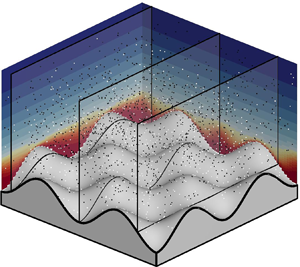Article contents
Transport of particles in a turbulent rough-wall pipe flow
Published online by Cambridge University Press: 02 December 2020
Abstract

Dense, small particles suspended in turbulent smooth-wall flow are known to migrate towards the wall. It is, however, not clear if the particle migration continues in a rough-wall flow and what the responsible mechanism is, especially with changing roughness parameters. Here, we address this using direct numerical simulation of a turbulent pipe flow of a fixed friction Reynolds numbers and changing the roughness size as well as the Stokes number of the particles. The transport and deposition mechanisms of particles are segregated into three different regimes dictated by the Stokes number. Particles with small Stokes number follow the carrier fluid and are affected by the turbulent structures of the rough wall. Flow separation in the wake of the roughness and stagnant flow in the trough of the roughness causes these particles to be trapped in the roughness canopy. Particles with very large Stokes number, on the other hand, are attracted to the wall due to turbophoresis and collide with the rough wall where the frequency of wall collision increases with increasing Stokes number. These ballistic particles are unaffected by the turbulent fluctuations of the flow and their trajectory is determined by the roughness topography. At intermediate Stokes numbers, the transport of the particles is influenced by both the wall collisions and also the turbulent flow. Particles in this range of Stokes number occasionally collide with the wall and are entrained by the turbulent flow. In this regime, the particles may have a mean streamwise velocity that is larger than the bulk flow rate of the fluid. Finally, we observe that bulk particle velocity scale better with a time scale based on the roughness elements rather than the usual viscous time scale.
Information
- Type
- JFM Papers
- Information
- Copyright
- © The Author(s), 2020. Published by Cambridge University Press
References
REFERENCES
- 13
- Cited by


